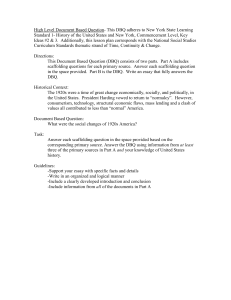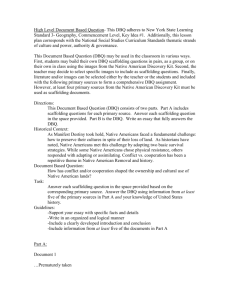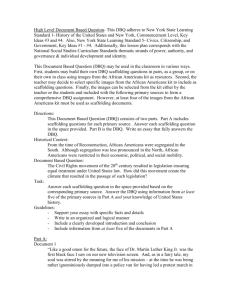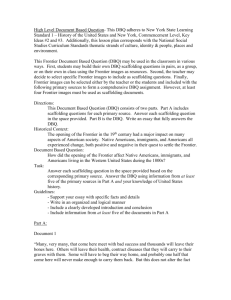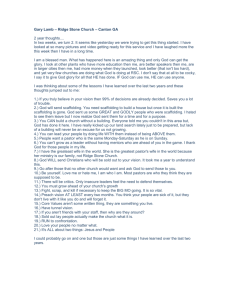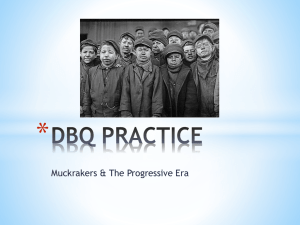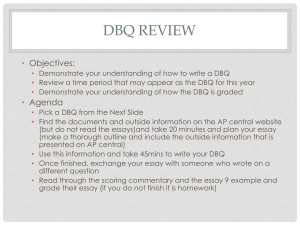beginner level lesson plan
advertisement
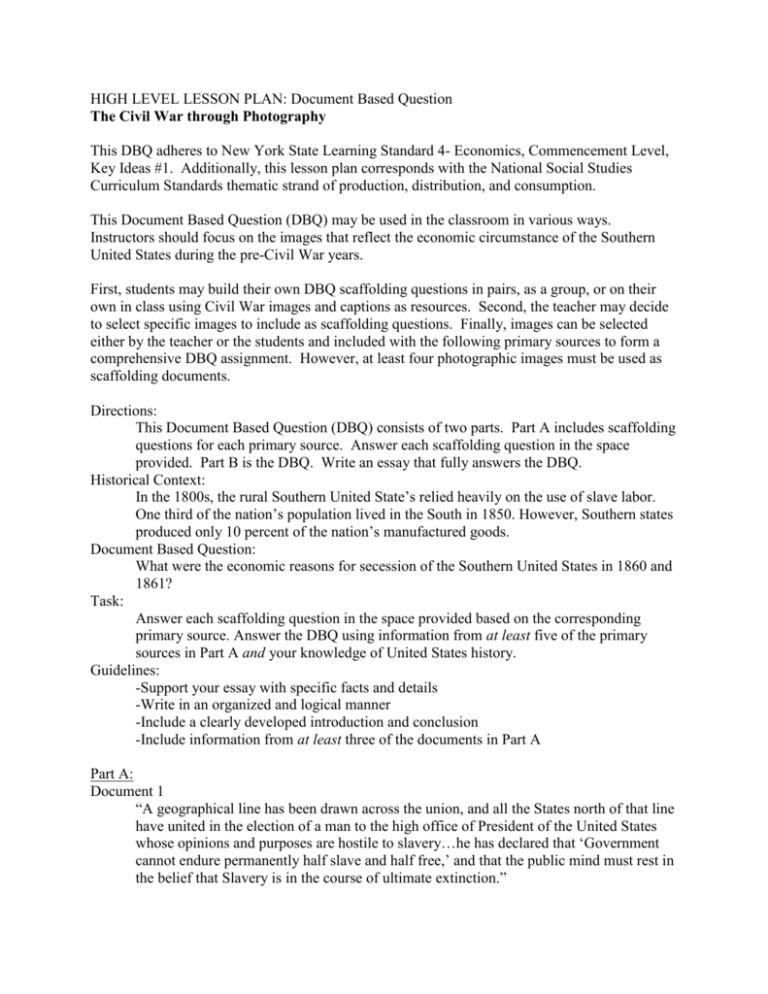
HIGH LEVEL LESSON PLAN: Document Based Question The Civil War through Photography This DBQ adheres to New York State Learning Standard 4- Economics, Commencement Level, Key Ideas #1. Additionally, this lesson plan corresponds with the National Social Studies Curriculum Standards thematic strand of production, distribution, and consumption. This Document Based Question (DBQ) may be used in the classroom in various ways. Instructors should focus on the images that reflect the economic circumstance of the Southern United States during the pre-Civil War years. First, students may build their own DBQ scaffolding questions in pairs, as a group, or on their own in class using Civil War images and captions as resources. Second, the teacher may decide to select specific images to include as scaffolding questions. Finally, images can be selected either by the teacher or the students and included with the following primary sources to form a comprehensive DBQ assignment. However, at least four photographic images must be used as scaffolding documents. Directions: This Document Based Question (DBQ) consists of two parts. Part A includes scaffolding questions for each primary source. Answer each scaffolding question in the space provided. Part B is the DBQ. Write an essay that fully answers the DBQ. Historical Context: In the 1800s, the rural Southern United State’s relied heavily on the use of slave labor. One third of the nation’s population lived in the South in 1850. However, Southern states produced only 10 percent of the nation’s manufactured goods. Document Based Question: What were the economic reasons for secession of the Southern United States in 1860 and 1861? Task: Answer each scaffolding question in the space provided based on the corresponding primary source. Answer the DBQ using information from at least five of the primary sources in Part A and your knowledge of United States history. Guidelines: -Support your essay with specific facts and details -Write in an organized and logical manner -Include a clearly developed introduction and conclusion -Include information from at least three of the documents in Part A Part A: Document 1 “A geographical line has been drawn across the union, and all the States north of that line have united in the election of a man to the high office of President of the United States whose opinions and purposes are hostile to slavery…he has declared that ‘Government cannot endure permanently half slave and half free,’ and that the public mind must rest in the belief that Slavery is in the course of ultimate extinction.” Ordinance of Secession Unanimously approved by the State Legislature December 10, 1860 Scaffolding Question: What reason does this Ordinance point out as a cause for secession? Document 2 “The hands are required to be in the cotton field as soon as it is light in the morning, and, with the exception of ten or fifteen minutes, which is given them at noon to swallow their allowance of cold bacon, they are not permitted to be a moment idle.” Solomon Northrup Twelve Years a Slave 1890 Scaffolding Question: Why are the slaves not permitted a moment to be idle? Document 3 Slaves Owned in Groups of 10-99………………………………………61% Slaves Owned in Groups of 1-9…………………………………………25% Slaves Owned in Groups of 100 or more………………………………..8% Free African Americans…………………………………………………6% African American Population Southern United States 1860 Scaffolding Question: What percentage of the African American population in the Southern United States during 1860 worked as forced labor? Document 4 “Slavery is that system of labor which exchanges subsistence for work, which secures a lifemaintenance from the master to the slave, and gives a life-labor from the slave to the master. The slave is an apprentice for life, and owes his labor to his master; the master owes support, during life, to the slave. Slavery is the negro system of labor. Slavery makes all work, and it ensures homes, food and clothing for all. It permits no idleness, and it provides for sickness, infancy and old age. It allows no tramping or skulking, and it knows no pauperism.” William John Grayson The Hireling and the Slave 1855 Scaffolding Question: Does this author portray slavery as positive or negative? How? APPENDIX 1 Student name: Date: What is a Hero? Definitions: Soldier: Civil War: Hero: American Civil War Heroes: Northern Southern
